Contents
- UN rights body to move SC on CAA
- Apex body on river linking in pipeline
- The SARS-CoV-2 is mutating, say scientists
- India wakes up as fresh Covid infections reach 6
- Black carbon levels spike at Himalayan glaciers
- Government yet to notify CVC, CIC appointments
- Rupee in free fall on COVID-19 fears; RBI soothes market
- Cut in Budgetary allocation will jeopardise tourism: House panel
- Species in news: Swamp Wallaby
UN RIGHTS BODY TO MOVE SC ON CAA
Focus: GS-II Governance, International Relations, Prelims
Why in news?
- In an unprecedented and rare move, the Geneva-based Office of the High Commissioner for Human Rights (OHCHR) has announced that it plans to file an application in the Supreme Court, asking to be impleaded in petitions challenging the Citizenship (Amendment) Act (CAA).
- And the Ministry of External Affairs (MEA) said the United Nations body had no right to file a petition that will ask the court to appoint the Commissioner for Human Rights as an assistant or ‘amicus curiae’ in the case.
Details

- The High Commissioner [Michelle Bachelet] intends to submit an ‘amicus curiae’ brief shortly on the Citizenship [Amendment] Act [CAA] in the Indian Supreme Court, in accordance with the Court’s established procedures.
- The amicus curiae will focus on providing an overview of relevant and applicable international human rights standards and norms to support the Court’s deliberations in the context of its review of the CAA
- The OHCHR plan has been criticised by diplomatic and legal experts as an “overreach” by it.
Implications for India
- The Citizenship Amendment Act is an internal matter of India and concerns the sovereign right of the Indian Parliament to make laws.
- NO foreign party has any locus standi on issues pertaining to India’s sovereignty.
- The CAA has to be tested on the touchstone of the Indian Constitution and not U.N. Convention.
- If such interventions as ‘amicus curiae’ are allowed, it might set a wrong precedent
- The U.N. rights body’s move as “absolutely unprecedented in the diplomatic history of India”.
Background
- The Citizenship (Amendment) Act (CAA), 2019 seeks to amend the Citizenship Act, 1955.
- The Citizenship Act,1955 provides various ways in which citizenship may be acquired. It provides for citizenship by birth, descent, registration, naturalisation and by incorporation of the territory into India.
- The CAA Bill was enacted on December 12, 2019 after it was cleared by Parliament.
- It promises to fast-track citizenship for undocumented migrants belonging to six faiths not including Islam and Judaism, who fled from religious persecution in Bangladesh, Afghanistan and Pakistan before December 21, 2014.
Office of the High Commissioner for Human Rights (OHCHR)
- The Office of the United Nations High Commissioner for Human Rights, is commonly known as the Office of the High Commissioner for Human Rights (OHCHR) or the UN Human Rights Office.
- OHCHR is a department of the Secretariat of the United Nations that works to promote and protect the human rights that are guaranteed under international law and stipulated in the Universal Declaration of Human Rights of 1948.
- The office was established by the UN General Assembly on 20 December 1993 in the wake of the 1993 World Conference on Human Rights.
- The office is headed by the High Commissioner for Human Rights, who co-ordinates human rights activities throughout the UN System and acts as the secretariat of the Human Rights Council in Geneva, Switzerland.
The objectives of OHCHR are to:
- Promote universal enjoyment of all human rights by giving practical effect to the will and resolve of the world community as expressed by the United Nations
- Play the leading role on human rights issues and emphasize the importance of human rights at the international and national levels
- Promote international cooperation for human rights
- Stimulate and coordinate action for human rights throughout the United Nations system
- Promote universal ratification and implementation of international standards
- Assist in the development of new norms
- Support human rights organs and treaty monitoring bodies
- Respond to serious violations of human rights
- Undertake preventive human rights action
- Promote the establishment of national human rights infrastructures
- Undertake human rights field activities and operations
- Provide education, information advisory services and technical assistance in the field of human rights.
APEX BODY ON RIVER LINKING IN PIPELINE
Focus: GS-II Governance, Prelims
Why in news?
- The Central government is working on the establishment of an exclusive body, called the National Interlinking of Rivers Authority (NIRA), to implement projects for linking rivers.
- NIRA is expected to take up both inter-State and intra-State projects.
- It will also make arrangements for generating up funds, internally and externally.
- The subject of establishment of the Authority, NIRA, was discussed at the meeting of the Special Committee on Inter-Linking of Rivers (ILR) in February 2020.
ILR in India
- The Indian Rivers Inter-link is a proposed large-scale civil engineering project that aims to effectively manage water resources in India by linking Indian rivers by a network of reservoirs and canals to enhance irrigation and groundwater recharge, reduce persistent floods in some parts and water shortages in other parts of India.
- The Inter-link project has
been split into three parts:
- Northern Himalayan rivers inter-link component
- Southern Peninsular component and starting 2005
- Intrastate rivers linking component.
- The project is being managed by India’s National Water Development Agency (NWDA), under its Ministry of Water Resources.
NWDA
- The National Water Development Agency (NWDA), a Registered Society under the Ministry of Water Resources, was set up in the year 1982.
- It was established to carry out the water balance and other studies on a scientific and realistic basis for optimum utilisation of Water Resources of the Peninsular rivers system.
- It was also tasked to prepare feasibility reports and give concrete shape to Peninsular Rivers Development Component of National Perspective.
- In 1990, it was also entrusted with the task of Himalayan Rivers Development Component of National Perspectives. Recently, the functions of NWDA have been further modified and the work of preparation of detailed Project Reports (DPR) of various link proposals and Pre-feasibility Reports.
- It has been also entrusted to prepare feasibility reports of intra-State links as proposed by the States.
ILR Projects in Consideration
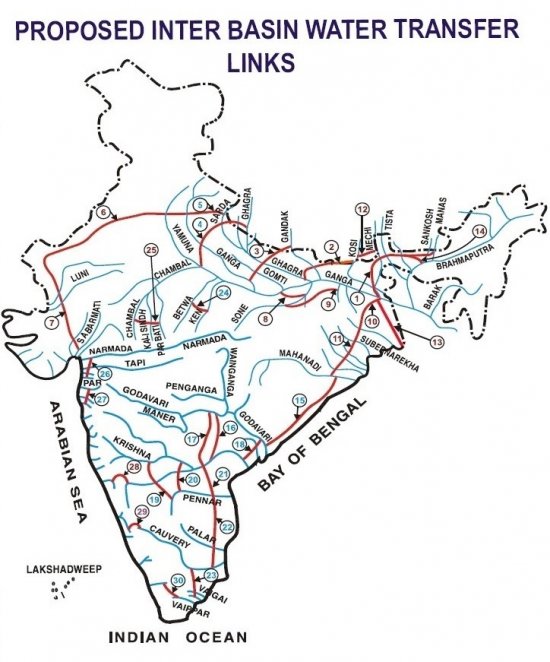
As of now, six ILR projects have been under examination of the authorities.—
- Ken-Betwa,
- Damanganga- Pinjal,
- Par-Tapi-Narmada,
- Manas-Sankosh-Teesta-Ganga,
- Mahanadi-Godavari and
- Godavari-Cauvery (Grand Anicut)
With regard to the peninsular rivers, the Centre has chosen to focus on the Godavari-Cauvery link.
Benefits of the Interlinking of River Projects
India receives most of its rain during monsoon season from June to September
Most of it falls in northern and eastern part of India. The amount of rainfall in southern and western part are comparatively low, and hence, these places which will have shortage of water.
- Therefore, Interlinking of rivers will help these areas to have water throughout the year.
- It will reduce the dependence of farmers on monsoon rains.
- Revenues for the States will increase with increasing production of Crops.
- The economic impact of the failure of a single monsoon is very substantial, hence a reduction in the dependency on monsoons rains will reduce the debilitating economic impact.
- It will ease the water shortages in Western and Southern India.
- It will help mitigating the impacts of recurrent floods in Eastern India.
- Water from the basins that are affected by floods almost every year (Ganga, Brahmaputra) can be diverted to other areas where there is scarcity of water; this can be achieved by linking the rivers.
- Thus – There are Advantages in Both – Controlling Floods and Reducing Scarcity of Water.
- The river interlinking project claims to generate total power of 34,000 MW (34 GW) and India needs clean energy to fuel its development processes. Hence the ILR Projects can help with India’s Energy needs.
- Socio-economic life of people will improve as the water needs get fulfilled.
- Inter-state water disputes can also be handled after implementation of ILR Projects.
- Transportation through navigation will Increase Income Sources and increase connectivity.
- Fishing in rural areas can also be improved as a result of ILR Projects.
Arguments Against ILP Projects
- Concerned scholars questioned the merits of inter-link projects citing lack of holistic assessment of social-ecological impacts like water-logging, salinisation and the resulting desertification.
- The concerns about sediment management, especially on the Himalayan system loom large. When the idea is to transfer water from the ‘surplus’ Himalayan river systems to ‘deficit’ basins of the southern part of India, the differential sediment regime defining the flow regimes need to be plugged into the equation. This will entail changes in ecosystem structures in both parts.
- Damming India’s east-coast rivers to take their water westwards will curtail downstream flooding and thereby, the supply of sediment—a natural nutrient—destroying fragile coastal ecosystems and causing coastal and delta erosion
- The spirit of federalism is ignored in the river interlinking project. There is dissent on the part of the state governments (Kerala).
Way Forward
- Local solutions (like better irrigation practice) and watershed management, should be focused on.
- The government should alternatively consider the National Waterways Project (NWP) which “eliminates” friction between states over the sharing of river waters since it uses only the excess flood water that goes into the sea unutilized
- The necessity and feasibility of river-interlinking should be seen on case to case basis, with adequate emphasis on easing out federal issues.
THE SARS-COV-2 IS MUTATING, SAY SCIENTISTS
Focus: Science and Technology
Why in news?
- Senior scientists at Australia’s national science agency, the Commonwealth Scientific and Industrial Research Organisation (CSIRO), have said the virus dubbed SARS-CoV-2 is mutating, after analysing the 115 published genome sequences from the current COVID-19 outbreak.
- Some of these ‘errors’ in the virus known as ‘mutations’ may be significant for the development and evaluation of new diagnostics, drugs and vaccines
Mutation
- A Mutation occurs when a DNA gene is damaged or changed in such a way as to alter the genetic message carried by that gene.
- A Mutagen is an agent of substance that can bring about a permanent alteration to the physical composition of a DNA gene such that the genetic message is changed.
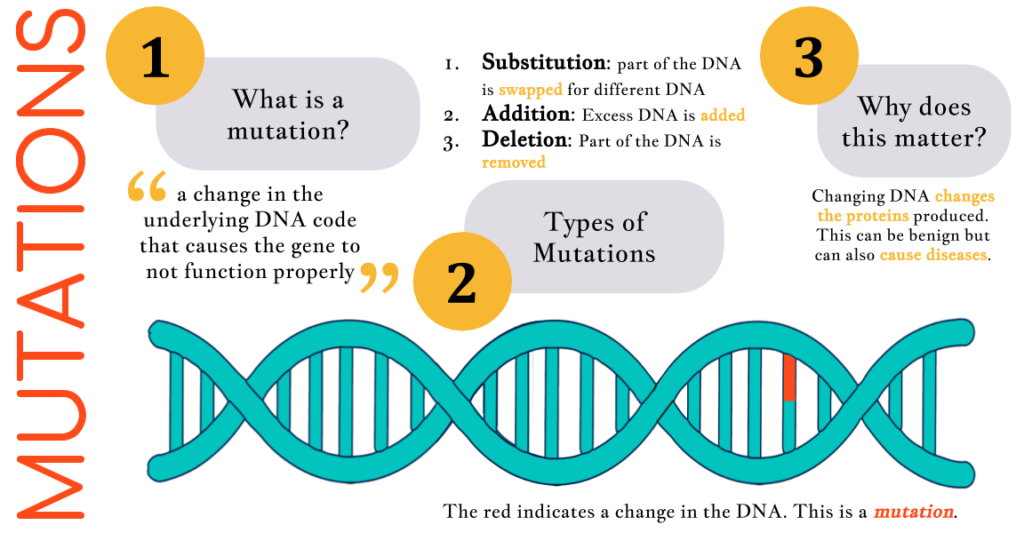
BLACK CARBON LEVELS SPIKE AT HIMALAYAN GLACIERS
Focus: GS-III Environment and Ecology, Prelims
Why in news?
Black carbon concentrations near the Gangotri glacier rose 400 times in summer due to forest fires and stubble burning from agricultural waste, and triggered glacial melt, says a study by scientists at the Wadia Institute of Himalayan Geology (WIHG).
Details
- The team of scientists from WIHG- measured variations of black carbon concentration at Chirbasa, near the Gangotri glacier in the Indian Himalaya, and located at an altitude of 3,600 metres, during the year 2016.
- The monthly mean concentration of EBC (equivalent black carbon) was found to be minimum in August 2020 and maximum in the month of May 2020.
- The observed seasonal mean concentrations of EBC indicated a pristine glacial source and an absence of EBC sources in the locality
What is Black Carbon?
- Black carbon is a potent climate-warming component of particulate matter formed by the incomplete combustion of fossil fuels, wood and other fuels.
- Complete combustion would turn all carbon in the fuel into carbon dioxide (CO2), but combustion is never complete and CO2, carbon monoxide, volatile organic compounds, and organic carbon and black carbon particles are all formed in the process.
- The complex mixture of particulate matter resulting from incomplete combustion is often referred to as soot.
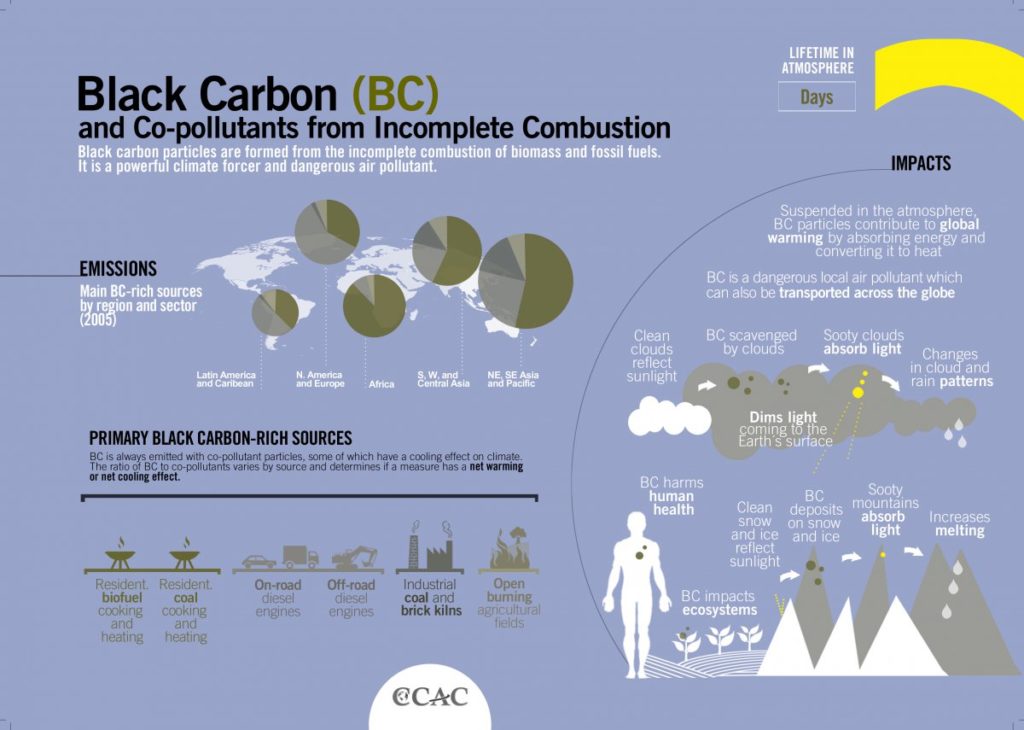
Adverse Effects of Black Carbon
- Black carbon is a short-lived climate pollutant with a lifetime of only days to weeks after release in the atmosphere.
- During this short period of time, black carbon can have significant direct and indirect impacts on the climate, glacial regions, agriculture and human health.
- Several studies have demonstrated that measures to prevent black carbon emissions can reduce near-term warming of the climate, increase crop yields and prevent premature deaths.
- Black carbon absorbs solar energy and warms the atmosphere.
- When it falls to earth with precipitation, it darkens the surface of snow and ice, reducing their albedo (the reflecting power of a surface), warming the snow, and hastening melting.
India and Black Carbon Emission
- India is the second largest emitter of black carbon in the world, with emissions expected to increase dramatically in the coming decades.
- Indo Gangetic plains are found to be the largest contributor.
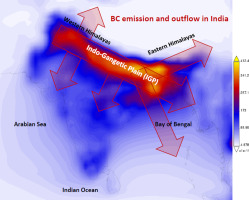
Extra Coverage:
Brown Carbon:
- Brown carbon is a carbonaceous aerosol which absorbs solar radiation over a broad range of wavelengths which is beginning to be seen as an important contributor to global warming.
- Brown Carbon absorbs both inorganic and organic pollutants, leading to serious effects on human health. Hence, Brown carbon (light-absorbing organic carbon) has attracted interest as a possible cause of climate change.
- Brown Carbon is a class of organic carbon, known for its light brownish colour, absorbs strongly in the ultraviolet wavelengths and less significantly going into the visible.
- Types of brown carbon include tar materials from smouldering fires or coal combustion, breakdown products from biomass burning, a mixture of organic compounds emitted from soil, and volatile organic compounds given off by vegetation.
| Brown Carbon | Black Carbon |
| Brown Carbon is brown in colour and its absorption is limited to UV and lower visible wavelengths. Aerosol absorption depends on the mass, mixing state, chemical composition and the refractive index of the species present in the atmosphere. | The ratio of Black Carbon to organic mass determines the colour of the particles which is in turn influenced by the burning conditions. Black carbon is dark in color and shows strong light absorbing capacity throughout the spectra. |
GOVERNMENT YET TO NOTIFY CVC, CIC APPOINTMENTS
Focus: GS-II Governance, Prelims
Why in news?
Two weeks after a high-power committee (HPC), chaired by Prime Minister Narendra Modi, selected the new Chief Vigilance Commissioner (CVC) and the Chief Information Commissioner (CIC), the Centre is yet to officially notify the appointments.
Department of Personnel and Training (DoPT) — the nodal Ministry that handles government postings.
CVC
- Central Vigilance Commission (CVC) is an apex Indian governmental body created in 1964 to address governmental corruption.
- In 2003, the Parliament enacted a law conferring statutory status on the CVC.
- It has the status of an autonomous body, free of control from any executive authority, charged with monitoring all vigilance activity under the Central Government of India, advising various authorities in central Government organizations in planning, executing, reviewing and reforming their vigilance work.
- The CVC was set up by the Government in February, 1964 on the recommendations of the Committee on Prevention of Corruption, headed by Shri K. Santhanam- The parliament enacted the CVC Act 2003 and set up the CVC.
- Hence, the CVC is a Statutory Body.
Functions of CVC
- The CVC receives complaints
on corruption or misuse of office and to recommend appropriate action.
Following institutions, bodies, or a person can approach to CVC:
- Central government
- Lokpal
- Whistle blowers
- It is not an investigating agency. The CVC either gets the investigation done through the CBI or through chief vigilance officers (CVO) in government offices.
- It is empowered to inquire into offences alleged to have been committed under the Prevention of Corruption Act, 1988 by certain categories of public servants.
- Its annual report gives the details of the work done by the commission and points to systemic failures which lead to corruption in government departments. Improvements and preventive measures are also suggested in the report.
CIC
- The Central Information Commission has been constituted with effect from 12-10-2005 under the Right to Information Act, 2005.
- Hence, CIC is a Statutory Body.
- The jurisdiction of the Commission extends over all Central Public Authorities.
- It was constituted to act upon complaints from those individuals who have not been able to submit information requests to a Central Public Information Officer or State Public Information Officer due to either the officer not have been appointed, or because the respective Central Assistant Public Information Officer or State Assistant Public Information Officer refused to receive the application for information under the Right to Information Act.
Functions of CIC
- Order enquiry into any matter on reasonable grounds only.
- Secure compliance of its decisions from any public authority.
- Receive and inquire into a
complaint from any person:
- Who has not received any response to his request for information within a specified time
- Who deems the information given to him/her incomplete, false or misleading, and any other matter related to securing the information
- Who has been unable to submit a request for information due to the non-appointment of an officer
- Who considers the fees so charged unreasonable
- Who was refused the information requested
- The commission has the power to examine any record under the control of the public authority. All such records have to be given to the Commission during examination and nothing shall be withheld.
- During inquiries, the CIC has
the powers of a civil court, such as the powers to:
- Summon and enforce the attendance of persons, and compel them to give oral or written evidence on oath and produce documents or things
- Require the discovery and inspection of documents
- Receive evidence on affidavit
- Requisition public records or copies from any office or court
- Issue summons for the examination of documents or witnesses
- Any other matter that may be prescribed
- The CIC also submits an annual report to the GOI on the implementations of the provisions of the Act. This report is then placed before both the Houses of Parliament.
RUPEE IN FREE FALL ON COVID-19 FEARS; RBI SOOTHES MARKET
Focus: GS-III Indian Economy
Why in news?
- The rupee fell for the third consecutive session on 3rd March 2020 on concerns over the deadly COVID-19 spreading in India amid the central bank stepping in to calm investor sentiment.
- The rupee dropped below the 73-a-dollar level even as the equity markets bounced back, snapping a seven-day losing streak.
Details
- The Reserve Bank of India (RBI) stepped in to issue a statement saying the central bank was closely monitoring the situation and stood ready to take appropriate action.
- The central bank acknowledged that the spill-over of the global financial market turmoil in India had been largely contained as there were hopes of coordinated policy action.
- Globally, financial markets have been experiencing considerable volatility, with the spread of the coronavirus triggering risk-off sentiments and flights to safe haven.
- Spill-overs to financial markets in India have largely been contained.
- Growing hopes of coordinated policy action to mitigate a broader fallout to economic activity have boosted market sentiment.
- The Reserve Bank of India is monitoring global and domestic developments closely and continuously and stands ready to take appropriate actions to ensure orderly functioning of financial markets, maintain market confidence and preserve financial stability.
Effects of COVID-19 on Export and Import
- Slowdown in economic activity in China is likely to weigh on exports from India. China’s economic growth is likely to moderate to below 6% in 2020.
- Export of commodities like ores (India exports 72% of its total ores to China), organic chemicals, cotton, etc. is likely to get hit should the disruption from the COVID-19 continue for an extended period
How is Value of Rupee Determined?
- The value of a currency, just like any other commodity, is determined by supply and demand. The supply of a currency and its demand in the market.
- No single institution or organization determines the exchange rate of rupee at present, not even the RBI.
- Rather, the exchange rate of rupee with foreign currencies is determined by a combination of market factors.
- By playing a direct hand in the supply and demand process RBI can maintain the fixed exchange rate.
Some of the Factors that determine Currency Exchange Rates are:
- International Parity Conditions
- Balance of Payments
- Economic Policies of a government (Fiscal Policy, Budget, Investment policy and Foreign Trade Policies) and a country’s central Bank (Cost of money, interest rates, monetary policy)
- General macroeconomic conditions of the country
- Inflation levels and trends
- Balance of Trade
- Market Psychology & perception
- General political stability
How was exchange rate of Rupee determined before 1990s?
- Prior to the period of economic liberalization in the 1990s, India followed a fixed exchange rate system.
- The Indian rupee was pegged to the US dollar and a basket of other currencies. In pegging, the value of a currency is fixed in a predetermined ratio to another more stable and internationally used currency or to a bunch of such currencies.
- Fixed exchange rate does not mean the value of the currency will not change. It means that the value of the currency will move in tandem with the currency or currencies to which it is pegged i.e., the ratio of the value of the currencies will be maintained.
- The exchange rate will not change every day but it may be reset on particular dates known as revaluation dates.
- In this economic system, the government or the RBI is the authority which ensured the exchange rate of the rupee is fixed with respect to other currencies.
CUT IN BUDGETARY ALLOCATION WILL JEOPARDISE TOURISM: HOUSE PANEL
Focus: GS-III Indian Economy, Economic Development
Why in news?
The Finance Ministry’s move to cut down the budgetary allocation for the Tourism Ministry in the 2019 financial year will ‘seriously jeopardise’ the targeted tourism outcomes during 2020-21, a Parliamentary panel has said in its report.
Details
- The huge mismatch between the projected demand for funds and actual allocations made for the Ministry of Tourism for the years 2018-19 and 2019-20 as well.
- The pattern of shortfall in allocation of funds indicated that budgetary requirements were being projected by the ministry more on the basis of theoretical anticipation rather than on actual trend of requirement.
| SWADESH DHARSHAN | PRASAD SCHEME |
| Swadesh dharshan is a theme based tourist circuit‘s development scheme. | The scheme is a National Mission on Pilgrimage Rejuvenation and Spiritual Augmentation Drive (PRASAD) under Ministry of Tourism. |
| Under the Swadesh Darshan scheme, the following thematic circuits have been identified, for development namely: North-East India Circuit, Buddhist Circuit, Himalayan Circuit, Coastal Circuit, Krishna Circuit, Desert Circuit, Tirtankar circuit, Tribal Circuit, Eco Circuit, Wildlife Circuit, Rural Circuit, Spiritual Circuit, Sufi circuit, Ramayana Circuit and Heritage Circuit. | Under the PRASAD scheme thirteen sites have been identified for development, namely: Amritsar, Ajmer, Dwaraka, Mathura, Varanasi, Gaya, Puri, Amaravati, Kanchipuram, Vellankanni, Kedarnath, Kamakhya and Patna. |
| In the ̳Spiritual Circuit‘ identified under the Swadesh Darshan scheme; the thrust is on development of particular thematic circuit consisting of various religious/spiritual destinations in a State and Union Territory. | Under the ̳PRASAD‘ scheme the focus is on development and beautification of the identified pilgrimage destinations |
Adopt a Heritage Project:
- It is an initiative of the Ministry of Tourism, in collaboration with the Ministry of Culture and the Archaeological Survey of India.
- It entails encouraging students, public sector and private organisations to participate more actively in the maintenance of Indian heritage.
- Under the scheme, government invites public sector companies, private sector firms as well as individuals, to develop selected monuments and heritage and tourist sites across India.
Incredible India 2.0 Campaign:
- President of India launched Incredible India 2.0 campaign and ―Adopt a Heritage‖ project on the occasion of World Tourism Day.
- The campaign will focus on developing at least 10 cities where the spirituality quotient, medical and wellness potential will be promoted.
- At present cities from UP — Ayodhya, Agra, Mathura, Varanasi-Sarnath, and Gorakhpur, Haryana – Kurukshetra, Assam – Guwahati, and Tamil Nadu – Kanyakumari have been identified for developing tourist circuits.
Jobs in the Tourism Industry:
India has created over 13.92 million jobs in the tourism sector, with over 10 million in education and health sectors. As per the data shared by the Minister of State for Tourism, the tourism sector contributed an estimated 5.06 per cent to the Gross Domestic Product (GDP) of the country during 2016-17.
- The gap will be 7.55 lakh in non-managerial level and 1.09 lakh in managerial cadre by 2020-21 in tourism and hospitality sector,” as per the data shared by the Ministry of Tourism.
- The medical tourism sector attracts around 4 million people every year for various health checkups and major surgeries, with a majority from neigbouring countries of Nepal, Bhutan, Bangladesh, the Middle East and African countries.
- Further, the hospitality industry presents huge job opportunities for women, which are bound to increase as a lot of female travelers prefer solo trips
Travel & Tourism Competitiveness Index (TTCI)
- The Travel & Tourism Competitiveness Index (TTCI), that covered 140 economies, measures the set of factors and policies that enable sustainable development of travel and tourism sector which contributes to the development and competitiveness of a country.
- Spain held on to the top spot in the World Economic Forum’s (WEF) latest Travel and Tourism Competitiveness Report (TTCR), which ranked 140 countries on their relative strengths in global tourism and travel.
Barrier-free tourism
In 2018, Kerala Government launched the barrier-free tourism project to make prime tourist spots in the state accessible for people with disabilities.
SPECIES IN NEWS: SWAMP WALLABY
Focus: GS-III Environment and Ecology
Why in news?
The swamp wallaby is likely the only mammal pregnant and lactating all life long, researchers have said.
How is it possible?
- Female wallabies and
kangaroos have two uteri and two separate ovaries.
At the end of a pregnancy in one uterus, a new embryo develops in the other uterus. - Kangaroos and wallabies regularly have an embryo in the uterus, a young joey in the pouch, and a third semi-dependent young at foot, still drinking its mother’s milk.
- In kangaroos, the new embryo is conceived a day or two after the previous birth.
- In the swamp wallaby (Wallabia bicolor), the new conception happens one or two days before the previous birth.
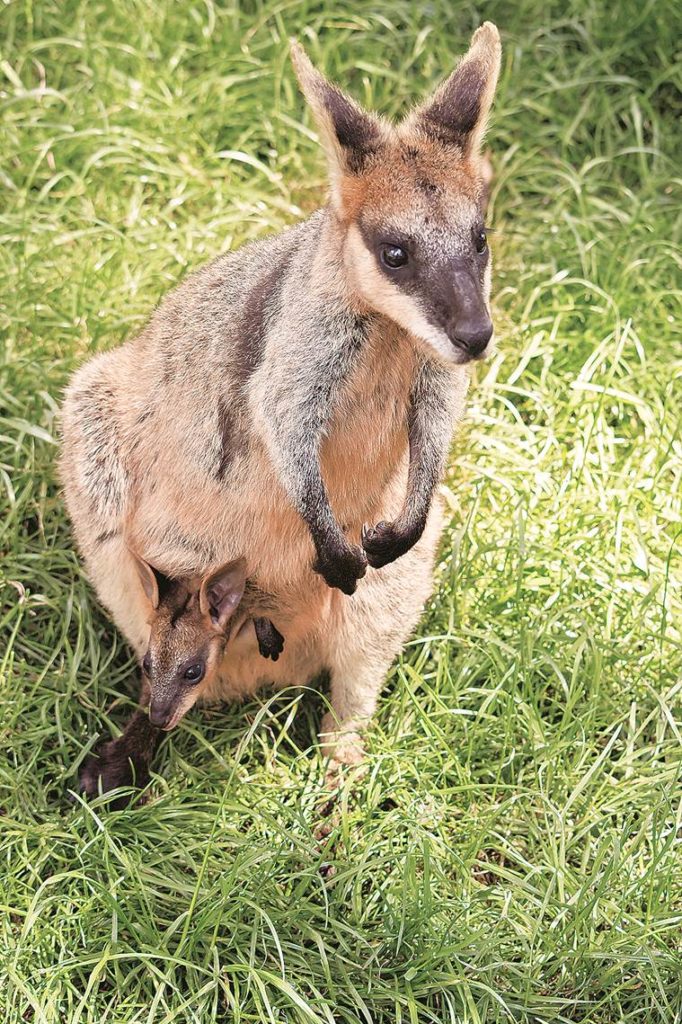
What happens after birth?
- As soon as the mature foetus is born and settles in the pouch, the swamp wallaby arrests the development of the new embryo.
- This is called embryonic diapause, which happens in many animals to pause reproduction until the conditions are right — season, climate, food availability.
- For wallabies, this is also to ensure that the new one is born only when the pouch is free again.
- If this did not happen, the swamp wallaby would be birthing new young every 30 days — it has a short gestation period — and its pouch could not support that.
The hare parallel:
- There is only one other mammal, the European brown hare (Lepus europaeus), that conceives additional embryos before giving birth.
- There are, however, two key differences. In the hare, the new embryos are conceived in the same uterus that is already supporting foetuses in late stages — which, the researchers note, may be all the more remarkable.
- The other difference is that only the swamp wallaby is pregnant all its life.
- “The hare is only pregnant with the possibility of conceiving new embryos during distinct breeding seasons over about 5-6 months of the year. The rest of the time it is not pregnant or lactating at all.
About Swamp Wallaby:

- The swamp wallaby is a small macropod marsupial of eastern Australia.
- It inhabits thick undergrowth in forests and woodlands, or shelter during the day in thick grass or ferns, emerging at night to feed.



